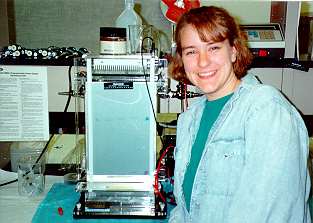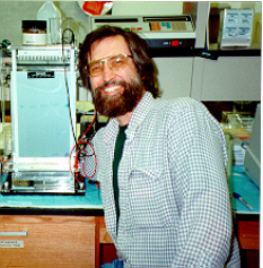 |
|
|
ResearchProjects |
|
|
Awarded (9/06/02) NSF Grant (#0223089) as a Co-Principal Investigator with Wade Hazel (PI) and Bryan Hanson, “Theoretical and Empirical Studies of a Conditional Strategy: Environmentally Cued Pupal Color in Swallowtail Butterflies.” $841,000.00 fund, 4 year grant. 2002 |
|
Awarded (12/21/01) NSF Grant (#0126409) as Principal Investigator, “Discovering rRNA and Homeobox Genes by DNA Sequencing and Bioinformatics in an Undergraduate Molecular Biology Course.” $181,000.00 matching fund, two year grant. 2001 |
See: Research Interests and Projects in the Fornari Lab
The old, manual "slab-gel" Sequencing apparatus: |
 |
|
|
 |
|
|
The new automated Sequencing
apparatus:
|
 Brian Bales ('04 Biochemistry) and Sonia Olikara ('04 Biochemistry) with the CEQ 8000 Gene Analysis System in room 219 of Olin (the DNA Sequencing & Bioinformatics Lab)*The entire Sequencing Lab with all the necessary equipment for performing cycle-sequencing chemistry, processing and purifying reaction products, sequencing and analyzing the results, as well as some necessary equipment for isolating DNA, performing PCR, and cloning DNA fragments, was made possible by NSF grant awards to C. Fornari.Our Sequencing Protocols for the CEQ 8000(under contiunous development!) |
Research Interests and Projects in the Fornari Lab
"Each creature is but a patterned gradation (Schattierung) of one great harmonious whole."
Goethe - from chapter 2, p. 21 of The Web of Life by Fritjof Capra
|
"Yet in no other branch of Biology are the different explanatory aspects of the life sciences represented in such exemplary fashion as in developmental biology. This discipline is highly analytical (often misleadingly called reducionist), with the goal of determining the contribution that each gene makes to the developmental process. At the same time it is conspicuously holistic, since viable development depends on the influence of the organism as a whole, reflected by the interaction among genes and tissues. The decoding of the genetic program represents the proximate causation of ontogenetic processes, while the contents of the genetic program are the results of ultimate (evolutionary) causations. It is this richness of factors and causations that is the fascination and beauty of the living world." Ernst Mayr (1997); p.174 of This is Biology: The Science of the Living World "The discovery of homeoboxes allowed molecular geneticists to 'go fishing' for vertebrate genes that might be related to the homeotics of Drosophila - the key to segmental architecture in insects. Forget all the folk wisdom about big ones that got away; this has been one of the finest fishing expeditions in human history." Stephen Jay Gould (1991). "Of Mice and Mosquitos." Natural History July 1991, 12-20. Other excellent sources for Developmental Biology/Genetics: Eric H. Davidson (2006). The Regulatory Genome: Gene Regulatroy Networks in Development and Evolution Rudolf A. Raff (1996). The Shape of Life: Genes, Development, and the Evolution of Animal Form. Scott F. Gilbert (2006). Developmental Biology. Stuart A. Kauffman (1993). The Origins of Order: Self-Organization and Selection in Evolution. Sean Carroll, Jennifer Grenier, and Scott Weatherbee (2004). From DNA to Diversity: Molecular Genetics and the Evolution of Animal Design. |